方位介词
- 格式:ppt
- 大小:467.50 KB
- 文档页数:19
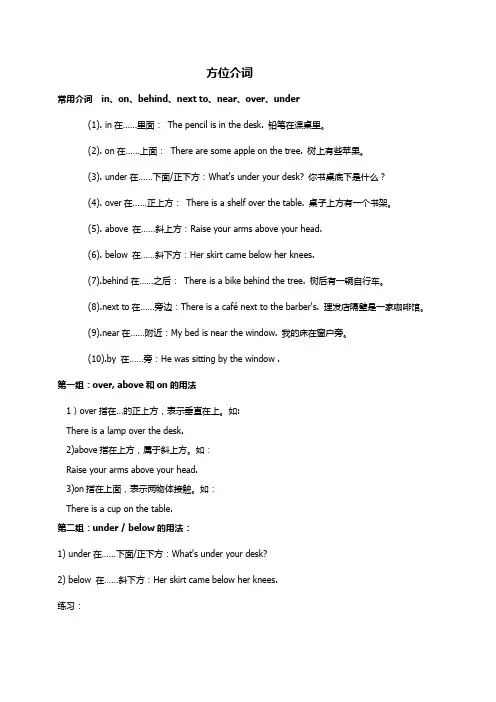
方位介词常用介词in、on、behind、next to、near、over、under(1). in在……里面:The pencil is in the desk. 铅笔在课桌里。
(2). on在……上面:There are some apple on the tree. 树上有些苹果。
(3). under在……下面/正下方:What's under your desk? 你书桌底下是什么?(4). over在……正上方:There is a shelf over the table. 桌子上方有一个书架。
(5). above 在……斜上方:Raise your arms above your head.(6). below 在……斜下方:Her skirt came below her knees.(7).behind在……之后:There is a bike behind the tree. 树后有一辆自行车。
(8).next to在……旁边:There is a café next to the barber's. 理发店隔壁是一家咖啡馆。
(9).near在……附近:My bed is near the window. 我的床在窗户旁。
(10).by 在……旁:He was sitting by the window .第一组:over, above和on的用法1)over指在…的正上方,表示垂直在上。
如:There is a lamp over the desk.2)above指在上方,属于斜上方。
如:Raise your arms above your head.3)on指在上面,表示两物体接触。
如:There is a cup on the table.第二组:under / below的用法:1) under在……下面/正下方:What's under your desk?2) below 在……斜下方:Her skirt came below her knees.练习:( ) 1 The boat is passing___ the bridge.A. throughB. belowC. underD. across( ) 2 Two planes are flying___ the city.A. throughB. over ,C. on , D, below( ) 3 We can see a river running to the east____ the hill.A. underB. belowC. overD. on( ) 4 Do you see the kite ___ the building.A. overB. crossC. onD. above第三组:in 和on表示“在……上”1,门一类——镶嵌在墙里的,用in,字画一类——挂在墙面上的,用on( ) 1 He put up a map ___ the back wall because there was a hole ___ it.A. on; onB. at; inC. on; inD. on; at( ) 2 There is a door___ the wall.A. onB. toC. ofD.in( ) 3 Any man ___ eyes______ his head can see that he's exactly like a rope.A. with; onB. with; inC. on; withD. in; with2,鸟一类落在树上的,用in;苹果一类长在树上的,用on( ) 1 There are some birds singing___ the trees.A. inB. onC. atD. from( ) 2 There are so many apples___ that tree.A. in B, on C. at D. from第四组:in /on/ to表示“接壤”B A B A BB 在A里——用in A和B相邻(接壤)—用on A和B不相邻(不接壤)—用to( ) 1 The United States is ____ the south of Canada and ___ the east of Japan.A. to; inB. on; toC. in; besideD. at; on( ) 2 The man stood____the window, watching the boys playing outside.A. inB. byC. withD. to( ) 3 Japan lies____ the east of China.A. on B/ to C. in D. with第五组:at, in表示“在……”1)at表示较小的地点。
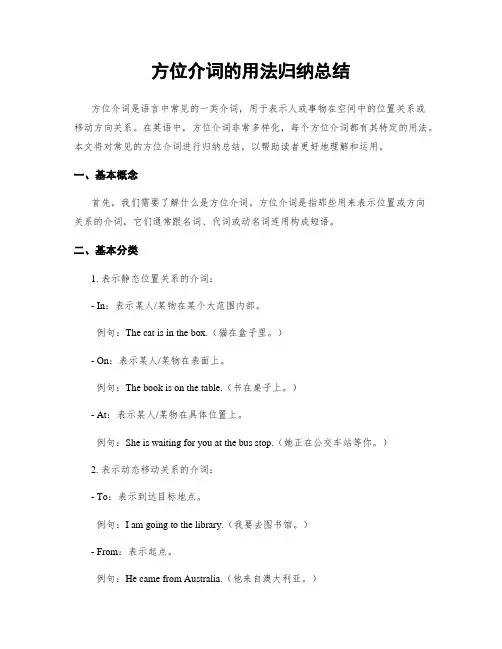
方位介词的用法归纳总结方位介词是语言中常见的一类介词,用于表示人或事物在空间中的位置关系或移动方向关系。
在英语中,方位介词非常多样化,每个方位介词都有其特定的用法。
本文将对常见的方位介词进行归纳总结,以帮助读者更好地理解和运用。
一、基本概念首先,我们需要了解什么是方位介词。
方位介词是指那些用来表示位置或方向关系的介词,它们通常跟名词、代词或动名词连用构成短语。
二、基本分类1. 表示静态位置关系的介词:- In:表示某人/某物在某个大范围内部。
例句:The cat is in the box.(猫在盒子里。
)- On:表示某人/某物在表面上。
例句:The book is on the table.(书在桌子上。
)- At:表示某人/某物在具体位置上。
例句:She is waiting for you at the bus stop.(她正在公交车站等你。
)2. 表示动态移动关系的介词:- To:表示到达目标地点。
例句:I am going to the library.(我要去图书馆。
)- From:表示起点。
例句:He came from Australia.(他来自澳大利亚。
)- Into:表示进入某个物体或空间。
例句:She went into the room.(她走进了房间。
)- Out of:表示从某个物体或空间中出来。
例句:The cat jumped out of the box.(猫从盒子里跳出来。
)三、特殊用法除了基本的位置关系和移动方向的表达,有些方位介词还有特殊的用法。
1. Above和over:- Above多用于静态位置,指在高于某人/某物之上。
例句:The birds are flying above the trees.(鸟儿在树顶上飞翔。
)- Over既可用于静态位置,也可用于动态移动,表示覆盖在某人/某物之上。
例句:He put a blanket over her shoulders.(他给她盖上一条毯子。
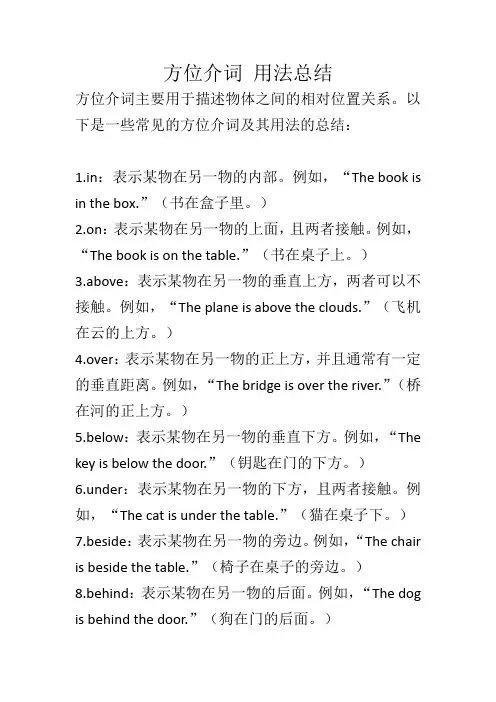
方位介词用法总结方位介词主要用于描述物体之间的相对位置关系。
以下是一些常见的方位介词及其用法的总结:1.in:表示某物在另一物的内部。
例如,“The book is in the box.”(书在盒子里。
)2.on:表示某物在另一物的上面,且两者接触。
例如,“The book is on the table.”(书在桌子上。
)3.above:表示某物在另一物的垂直上方,两者可以不接触。
例如,“The plane is above the clouds.”(飞机在云的上方。
)4.over:表示某物在另一物的正上方,并且通常有一定的垂直距离。
例如,“The bridge is over the river.”(桥在河的正上方。
)5.below:表示某物在另一物的垂直下方。
例如,“The key is below the door.”(钥匙在门的下方。
)6.under:表示某物在另一物的下方,且两者接触。
例如,“The cat is under the table.”(猫在桌子下。
)7.beside:表示某物在另一物的旁边。
例如,“The chair is beside the table.”(椅子在桌子的旁边。
)8.behind:表示某物在另一物的后面。
例如,“The dog is behind the door.”(狗在门的后面。
)9.in front of:表示某物在另一物的前面。
例如,“The car is in front of the house.”(车在房子的前面。
)10.between:表示某物在两者之间。
例如,“The apple is between the two oranges.”(苹果在两个橙子之间。
)请注意,这些方位介词有时会根据语境和具体的物体有所变化,以上总结仅为一般性的用法。
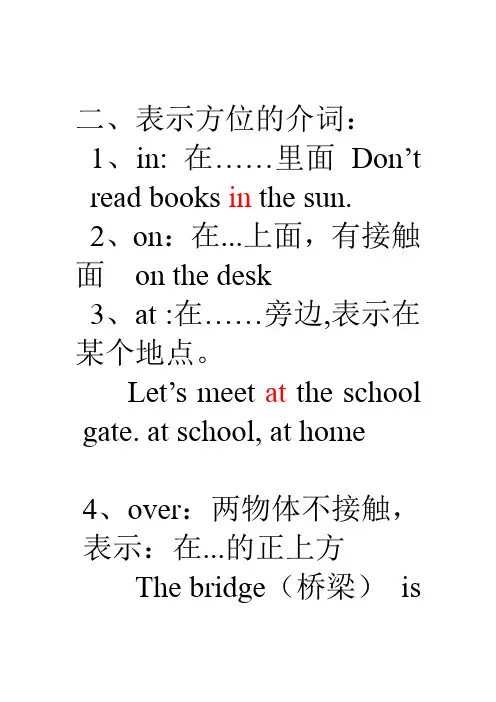
二、表示方位的介词:1、in: 在……里面Don’tread books in the sun.2、on:在...上面,有接触面on the desk3、at :在……旁边,表示在某个地点。
Let’s meet at the school gate. at school, at home 4、over:两物体不接触,表示:在...的正上方The bridge(桥梁)isover the river.5、under:在..的正下面。
(over与under 是一组反义词)The shoes are under the bed.6、below:在...下方(不一定是正下方)There are many fishes below the water.7、above:在...上方(不一定是正上方)A plane flew above the clouds. 飞机在云层上飞过。
8、near:近的,不远的The park is near our school.9、by:在...的旁边,比near 的距离要近The boy is standing by the window.10、beside在……旁边Li Ming lay beside Danny.11、around:在……周围,环绕,在....的四周The grass around myhouse is green.12、between:在两者之间What is the difference between A and B?13、among:在……中间(三者或三者以上)There is a tall man among these people.人群中有个高个子男人。
14、in front of:表示在(空间外部)...的前面There is a road in front of my house.15、in the front of:表示在(空间内部)...的前面The teacher is standing in the front of the classroom.16、behind:在...后边Jenny is sitting behind Kim.随堂练一、选择填空:1.Are you ____ Class 5?A. onB. atC. inD. of2.A bird is singing _____the tree.A. onB. atC. inD. with3. There is a map _______ the wall.A. ofB. onC. inD. at4. There are a lot of apples _____ that apple tree.A. withB. inC. onD. at5. He isn't ________ school today. He is _____ home. A. in, in B. at, inC. at, atD. on, at6. Is there a bus stop _____ here?A. byB. nearC. fromD.on7. Bob sits _____ Li Lei and Ling Tao.A. betweenB. amongC. onD.in8. There is a tree _____ the house.A. in front ofB. in the front ofC. amongD. of9. The blackboard is ________ the classroom. A. in front of B. in the front of C. among D. of10. The broom(扫帚) is _________the door.A. withB. inC. onD. behind11. He was sitting ______ the children, and telling them a story.A. betweenB. in front ofC. amongD. in12. The earth moves _______ the sun.A. withB. aroundC. onD. over二、用适当的介词填空。
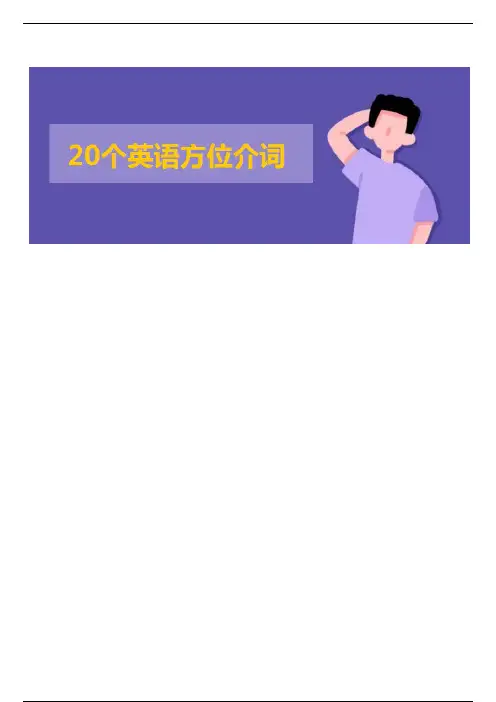
20个英语方位方位介词:in、on、over、under、above、below、by、beside、near 、next to、behind、before、outside、from、among、between等等。
—— 20个英语方位介词及释义 ——方位介词(1):in释义:在……之内例句:The students are reading in the classroom.学生们在教室里读书。
方位介词(2):on释义:在……上面例句:The boat is on the river.那条船在河上。
方位介词(3):over释义:在……(正)上方例句:There are several bridges over the river. 河上有好几座桥。
方位介词(4):under释义:在……(正)下方例句:The boat sailed under the bridge.船在桥下行驶。
方位介词(5):above释义:在……上方例句:The plane flew above the clouds.飞机在云上飞行。
方位介词(6):below释义:在……下方例句:The sun sinks below the horizon.太阳沉没在地平线下。
方位介词(7):by释义:在……旁边例句:Our house is by the river.我们的房子在河边。
方位介词(8):beside释义:Come and sit beside me.过来坐在我旁边。
方位介词(9):near释义:在……附近例句:Idon’t need a car becauseIlive nearthecity centre .我不需要汽车,因为我住在靠近市中心方位介词(10):next to释义:紧挨……例句:My best friend sits next to me in class.上课时我最好的朋友坐在我的旁边。
方位介词(11):behind释义:在……后面例句:Olive hid behind a tree.奥列弗藏在一棵树后面。
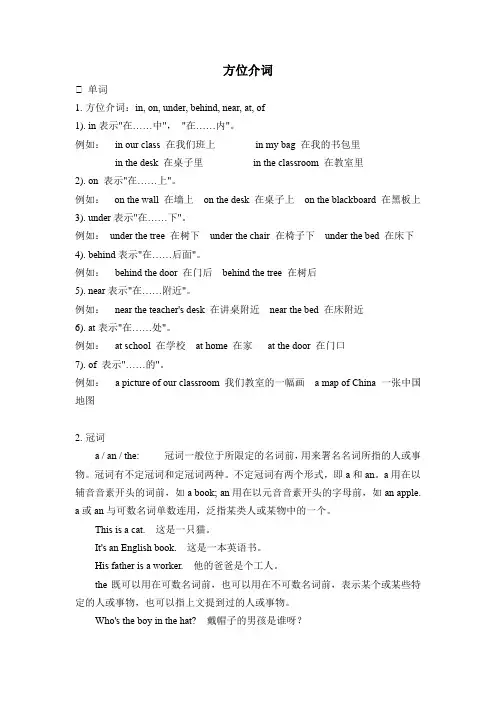
方位介词⑴单词1.方位介词:in, on, under, behind, near, at, of1). in表示"在……中","在……内"。
例如:in our class 在我们班上in my bag 在我的书包里in the desk 在桌子里in the classroom 在教室里2). on 表示"在……上"。
例如:on the wall 在墙上on the desk 在桌子上on the blackboard 在黑板上3). under表示"在……下"。
例如:under the tree 在树下under the chair 在椅子下under the bed 在床下4). behind表示"在……后面"。
例如:behind the door 在门后behind the tree 在树后5). near表示"在……附近"。
例如:near the teacher's desk 在讲桌附近near the bed 在床附近6). at表示"在……处"。
例如:at school 在学校at home 在家at the door 在门口7). of 表示"……的"。
例如: a picture of our classroom 我们教室的一幅画 a map of China 一张中国地图2.冠词a / an / the: 冠词一般位于所限定的名词前,用来署名名词所指的人或事物。
冠词有不定冠词和定冠词两种。
不定冠词有两个形式,即a和an。
a用在以辅音音素开头的词前,如a book; an用在以元音音素开头的字母前,如an apple. a或an与可数名词单数连用,泛指某类人或某物中的一个。
This is a cat. 这是一只猫。
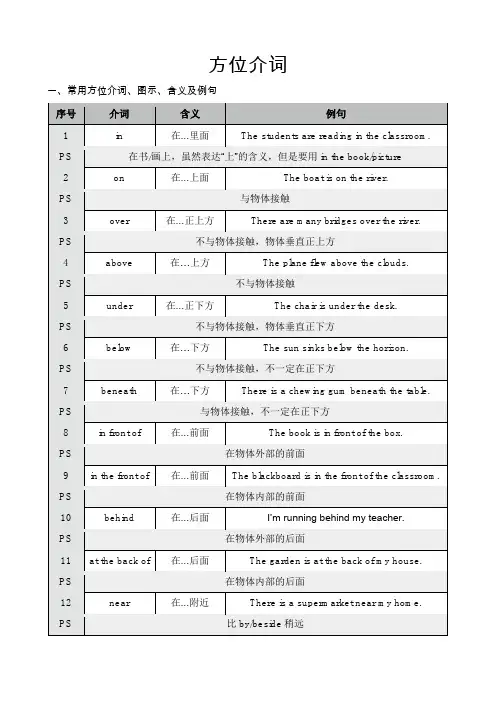
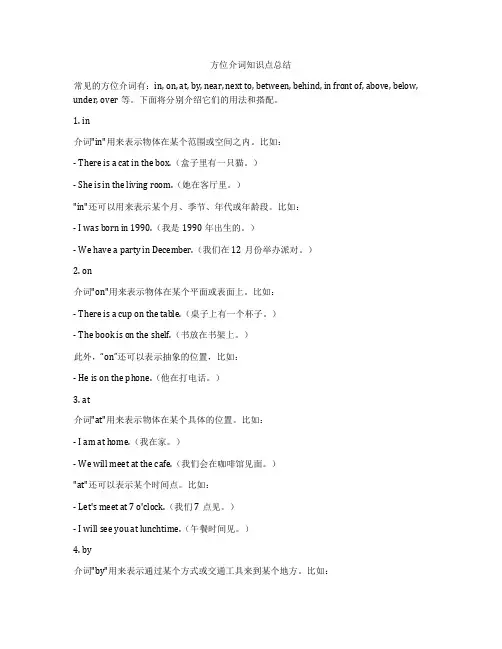
方位介词知识点总结常见的方位介词有:in, on, at, by, near, next to, between, behind, in front of, above, below, under, over等。
下面将分别介绍它们的用法和搭配。
1. in介词"in"用来表示物体在某个范围或空间之内。
比如:- There is a cat in the box.(盒子里有一只猫。
)- She is in the living room.(她在客厅里。
)"in"还可以用来表示某个月、季节、年代或年龄段。
比如:- I was born in 1990.(我是1990年出生的。
)- We have a party in December.(我们在12月份举办派对。
)2. on介词"on"用来表示物体在某个平面或表面上。
比如:- There is a cup on the table.(桌子上有一个杯子。
)- The book is on the shelf.(书放在书架上。
)此外,“on”还可以表示抽象的位置,比如:- He is on the phone.(他在打电话。
)3. at介词"at"用来表示物体在某个具体的位置。
比如:- I am at home.(我在家。
)- We will meet at the cafe.(我们会在咖啡馆见面。
)"at"还可以表示某个时间点。
比如:- Let's meet at 7 o'clock.(我们7点见。
)- I will see you at lunchtime.(午餐时间见。
)4. by介词"by"用来表示通过某个方式或交通工具来到某个地方。
比如:- He came by bus.(他乘公交车来了。
)- We can go by train.(我们可以坐火车去。
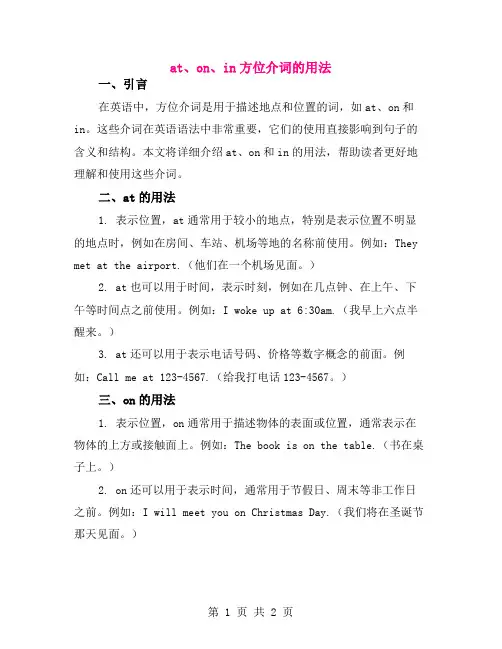
at、on、in方位介词的用法一、引言在英语中,方位介词是用于描述地点和位置的词,如at、on和in。
这些介词在英语语法中非常重要,它们的使用直接影响到句子的含义和结构。
本文将详细介绍at、on和in的用法,帮助读者更好地理解和使用这些介词。
二、at的用法1. 表示位置,at通常用于较小的地点,特别是表示位置不明显的地点时,例如在房间、车站、机场等地的名称前使用。
例如:They met at the airport.(他们在一个机场见面。
)2. at也可以用于时间,表示时刻,例如在几点钟、在上午、下午等时间点之前使用。
例如:I woke up at 6:30am.(我早上六点半醒来。
)3. at还可以用于表示电话号码、价格等数字概念的前面。
例如:Call me at 123-4567.(给我打电话123-4567。
)三、on的用法1. 表示位置,on通常用于描述物体的表面或位置,通常表示在物体的上方或接触面上。
例如:The book is on the table.(书在桌子上。
)2. on还可以用于表示时间,通常用于节假日、周末等非工作日之前。
例如:I will meet you on Christmas Day.(我们将在圣诞节那天见面。
)3. on还可以用于表示电视节目、广播节目等的播放时间。
例如:Please turn on the TV and watch the news at 7pm.(请打开电视在晚上七点观看新闻。
)四、in的用法1. 表示位置,in通常用于描述较大的地方或物体内部,例如房间、教室、学校、建筑物等场所的前面或里面。
例如:We meet in the classroom every day.(我们每天在教室见面。
)2. in还可以用于表示衣服或物体的尺寸或大小。
例如:She wears a dress in size 8.(她穿着8号的连衣裙。
)3. in也可以用于时间和年代的表述中,通常用于具体的日期或年份之前。
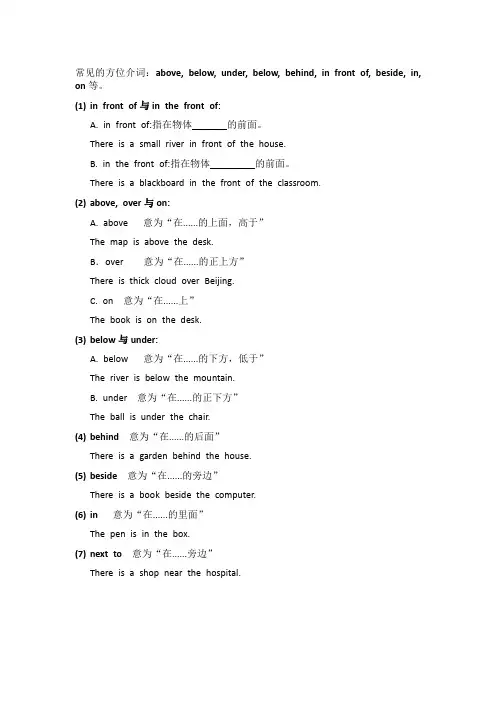
常见的方位介词:above, below, under, below, behind, in front of, beside, in, on等。
(1)in front of与in the front of:A. in front of:指在物体_______的前面。
There is a small river in front of the house.B. in the front of:指在物体_________的前面。
There is a blackboard in the front of the classroom.(2)above, over与on:A. above 意为“在......的上面,高于”The map is above the desk.B.over 意为“在......的正上方”There is thick cloud over Beijing.C. on 意为“在......上”The book is on the desk.(3)below与under:A. below 意为“在......的下方,低于”The river is below the mountain.B. under 意为“在......的正下方”The ball is under the chair.(4)behind 意为“在......的后面”There is a garden behind the house.(5)beside 意为“在......的旁边”There is a book beside the computer.(6)in意为“在......的里面”The pen is in the box.(7)next to意为“在......旁边”There is a shop near the hospital.。
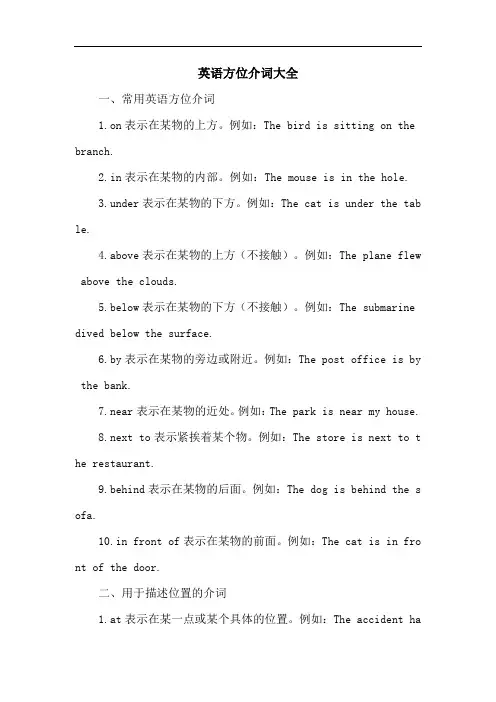
英语方位介词大全一、常用英语方位介词1.on表示在某物的上方。
例如:The bird is sitting on the branch.2.in表示在某物的内部。
例如:The mouse is in the hole.3.under表示在某物的下方。
例如:The cat is under the tab le.4.above表示在某物的上方(不接触)。
例如:The plane flew above the clouds.5.below表示在某物的下方(不接触)。
例如:The submarine dived below the surface.6.by表示在某物的旁边或附近。
例如:The post office is by the bank.7.near表示在某物的近处。
例如:The park is near my house.8.next to表示紧挨着某个物。
例如:The store is next to t he restaurant.9.behind表示在某物的后面。
例如:The dog is behind the s ofa.10.in front of表示在某物的前面。
例如:The cat is in fro nt of the door.二、用于描述位置的介词1.at表示在某一点或某个具体的位置。
例如:The accident happened at the intersection of two roads.2.in表示在一个较大的范围内或某个封闭的空间内。
例如:She lives in the city center.3.on表示在一个物体的表面或上方。
例如:The book is on the table.4.under表示在另一个物体的下方或内部。
例如:The box cont ains a book,and the book is under the lid of the box.5.above表示在一个物体的上方,但不一定紧挨着该物体。
方位介词英语
方位介词是指用来表示方向、位置、移动等概念的介词。
在英语中常用的方位介词包括in、on、at、under、over、between、among、behind、beside、with等。
这些方位介词在句子中的使用需要根据具体情境来确定,例如:
- In表示在一个封闭的空间内或时间段的内部,如in the room、in the morning。
- On表示在一个平面或表面上,如on the table、on the wall。
- At表示在某个地点或时间点,如at the park、at 2 o'clock。
- Under表示在某物的下方,如under the bed、under the tree。
- Over表示在某物的上方,如over the bridge、over the clouds。
- Between表示在两个物体或位置之间,如between the two chairs、between the river and the mountain。
- Among表示在多个物体或位置之间,如among the flowers、among the crowd。
- Behind表示在某物的后面,如behind the door、behind the car。
- Beside表示在某物的旁边,如beside the river、beside the bookshelf。
- With表示伴随或一起,如with my friends、with a cup of tea。
在学习和使用方位介词时,需要注意它们的用法和意义,并且要根据具体语境进行正确的运用。
英语常见方位介词1. on介词on表示“在某物之上”的意思,它通常表示一个物体在另一个物体之表面上面。
两者之间有接触。
例如:Your book is on the desk. 你的书在课桌上面。
There is a ball on the floor. 地板上有个球。
拓展:above 和over的区别on指的有接触面的上面,但是over和above都是没有接触面的上面。
over“在……正上方”,与under相对。
例如:There is a bridge over the river. 河上有一座桥。
The picture is hanging over the blackboard.那张图挂在黑板的正上方。
above只表示“在……上方或位置高出……”,不一定是正上方,与below相对。
例如:A plane flew above our heads. 一架飞机从我们头上飞过。
The Turners live above us. 特纳一家人住在我们的上面。
2. in介词in表示“在某物的里面”,它通常表示一个物体在另外一个物体的内部、中间或者在某个范围之内。
例如:Your pen is in the pencil case. 你的钢笔在铅笔盒里面。
She is the tallest in her class. 她是她们班最高的。
3. under介词under表示“在某物的下面”,它通常表示一个物体在另外一个物体的垂直正下面,两者之间没有接触。
例如:My bike is under the tree. 我的自行车在树的下面。
The shoes are under the chair. 鞋在椅子的下面。
拓展:under和below 的区别under表示“在……之下”,通常表示位置处于正下方,与介词over“在……上方”相对应。
例如:There is a book under the table. 桌子下面有一本书。
20个常用英语表方位介词常用的20个英语表方位介词有:in、on、at、under、over、above、below、in front of、behind、along、across、around、near、next to、by、beside、towards、inside、outside、to等等。
1、in:在……内部;在……里面的意思;What is in the box?盒子里有什么?2、on:在某物的上面,两者互相接触;My books are on that table.我的书在那张桌子上。
3、at:在……处,一般指较小的比较具体的地点;He isn't at school.He is at home.他不在学校,他在家。
4、under:表示在某物垂直的正下方,两者之间不接触;My cat is under my chair.我的猫在我的椅子下。
5、over:一种垂直悬空的上下关系,即“在正上方”,是under的相对反义词;Is there any bridge over the river?6、above: 在......上方,相对于另一者在上方7、below: 在......上方,相对于另一者在上方,是above的相对反义词;8、in front of:在……的前面,正好与behind相反;There are some big trees in front of our classroom. 我们教室前面有几棵大树。
9、behind:在某物体的后面。
The broom is behind the door.笤帚在门后。
10、along:沿着……,顺着……I'm walking along the river.我正沿河而行。
11、across:从一边到另一边,在……那边。
There are many trees across the river.河对岸有很多树。
12、around:“围绕,绕着”The house is built around a central courtyard.这房子是围绕着中央的庭院而建的。
满意答案好评率:20%我们已经学习了east, west, south, north, northeast, southeast等一些表示方位的词,在使用这些词表达方位时应注意以下几点: 1. 英汉表达的习惯不同:汉语中习惯把方位词的顺序排为“东西南北”;英语习惯则为north, south, east, west。
汉语中用“东南”、“东北”、“西南”、“西北”等表示方向,英语中则用southeast, northeast, southwest, northwest 表达。
2. 表示方位的名词east等一般应与定冠词the连用。
如:Shanghai is in the east of China.上海在中国的东部。
3. 表示方位的名词east, west等常与介词on, in, to连用,来表达两地的相互位置,但涵义却各有不同:1) 表示某地在某一特定区域内的方位时,介词用in。
如:Nanjing is in the south of Jiangsu. 南京在江苏的南部。
2) 表示某地在某一特定区域外,且两地相互接壤的某一方位时,介词用on。
如:Henan is on the west of Shandong. 河南在山东的西部。
3) 表示某地在某一特定区域外,但两地相互不相连的某一方位时,介词用to。
如:Japan is to the east of China. 日本在中国的东面。
4. east, west等方位词既可作名词又可作形容词。
作名词时常用于“ the +方位词+ of...”结构中,表示“……部”;作形容词时常构成具有行政区划意义的专有名词。
试比较:She works in the north of China.她在中国的北部工作。
She works in North China. 她在华北工作。
east, west作形容词时意为“东方的;东部的”、“西方的;西部的”。
一般说来,east, west 等常构成专有名词,且具有一定的政治意义或社会意义,其划分较为明确;而eastern, western只是单纯从地理方位上讲,无政治或社会意义,且划分较为模糊。
知识卡片:定义:方位介词:表示事物存在的方向和位置的介词叫方位介词。
注意事项:1.不能单独使用2.通常和后面的名词或代词构成介词短语。
即:方位介词(in/on/under)+定冠词the或形容词性物主代词等+名词用法:方位介词in、on、under的用法单词意义例句In 表示“在...中;在...里”,指某个空in our clsss在我们班里间的内部。
in my bag在我的包里on the wall在墙上on 表示“在...上”,指一个人或物在另一个人或物的上面。
on the floor在地板上under the chair在椅子下under 表示“在...下”,常指一个人或物在另一个人或物的下面。
under the tree在树下例题1.----Where is the blackboard?----It’s _________ the classroom.A.onB. inC. withD. under2.-----Where are the cat?----- It’s ___________ the boxA.onB. inC. withD. under3.----- Where is my box?------ It’s _________ the desk.A.onB. inC. withD. under4. ----- Where is my box?---- It’s _________ the chair.A.onB. inC. withD. under 练习:1.----Where's the cat ?---- It's ________ the desk .A.onB. inC. withD. under2. ----- Where's the ball ?---- It's ________ the chair .A.onB. inC. withD. under3. ----Where's the monkey ?---- It's ________ the box .A.onB. inC. withD. under4. The key are __________ _________ ____________.(在椅子下面)5.My English book is _______ _______ _________(在沙发上)6. The schoolbag is ________ ________ _______ (在我玛丽的房间里)总结:测评:1.It’s ______ the chair.2.The apple is _____the box3.It’s ________ the hat.4.It’s ________ the desk.作业1.-----Where is your brother?------ He is _______ the library.A.onB. inC. withD. under2. -----Where are your friends?------ They are playing _______ the playground.A.onB. inC. withD. under 二.用介词in,on或under填空.1. The map is _____ my room, ____ the wall.2. The hat is ____ your head.3. His bike is _______ the tree.4. Some birds are _____ the tree, and some apples are ____ it, too.5. The students are _____ the classroom.。